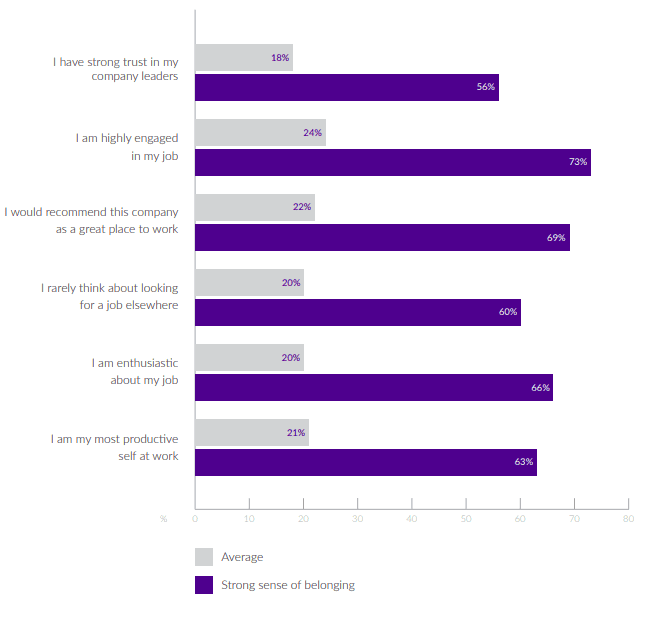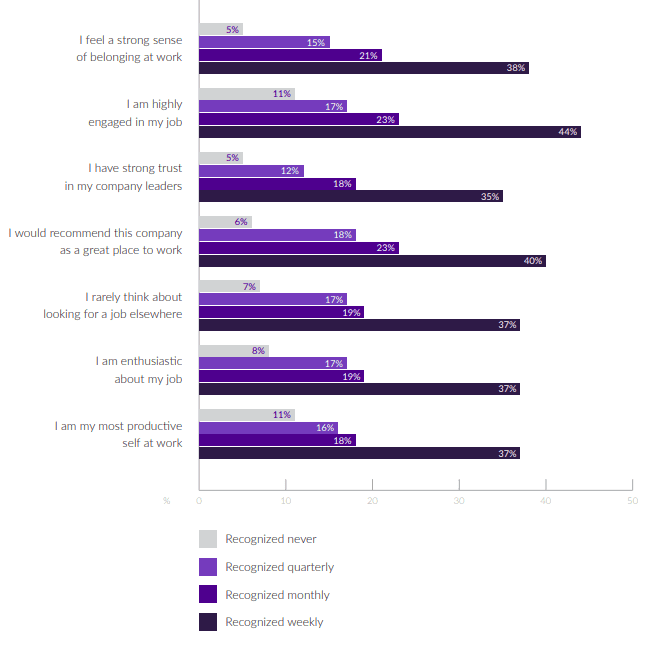Prioritize belonging to thrive in the future of work
Here’s how tech can help better connect dispersed workforces.
Why You Should Care
Employers are struggling to win the war for talent.
Could focusing on belonging be the solution?
Achievers thinks so, but only if employers also leverage the right technology.
The world of work has changed forever, but leaders are struggling to adjust.
According to the latest Achiever’s report, 56% of HR leaders say the C-Suite is resistant to make the changes necessary to be successful at attraction and retention, despite a war for talent. This is based on a survey of 1,400 HR professionals.
There is a clear discrepancy between leaders’ and employee’s views towards the office. Two-thirds of employees say their managers want them back in the office, while 85% of workers want to work remotely at least part of the time.
This disconnect is the main reason why workers are quitting in the ‘Great Resignation’. 38% of the 3,500 employees surveyed by Achievers said they would prefer to be fully remote, and this group is 44% more likely to have changed jobs since COVID-19 began.
In addition, the research from Achievers’ found that when organizations were open to remote work, they were 29% less likely to struggle with talent attraction and retention.
Not only is flexible working a major cause of high attrition rates, remote work is actually a net positive for employers. Remote workers are 21% more likely to be highly engaged at work.
But there is still work that employers need to do to avoid proximity bias, and ensure that those working from home have the same sense of connection and belonging as those in the office.
46% of those working from home are worried about missing out on career opportunities, 44% were concerned about missing out on work events.
How to digitize belonging
Ultimately, it seems that leaders are aware that connection and belonging is crucial – in fact, Achievers’ found that “a strong sense of belonging drives three times the level of employee engagement, commitment, productivity, and virtually anything else on the HR agenda. Strategically fostering a deep experience of belonging builds business performance”.

Belonging is defined as ensuring employees feel at home; Achievers’ report noted: “Belonging is the outcome of an organizational commitment to creating an environment that is diverse, inclusive, and engaging.”
But, of course, knowing how to improve belonging and connection, particularly for a dispersed workforce, is much easier said than done for business leaders.
Talking about the results, Achievers chief workplace scientist Dr Natalie Baumgartner tells UNLEASH: “Our study revealed that most people who changed jobs during the pandemic did so to gain better work flexibility.
“Some fear it’s not possible to fully integrate, engage, and motivate remote workers.
“A big part of solving this impasse, our study revealed, is technology.”
Achievers’ report said that organizations should particularly focus on finding the right technology in areas like connection, recognition, and wellbeing.
Dr Baumgartner adds: “For example, where organizations offered connection tools, they outperformed their peers on key factors including belonging (+34%), engagement (+28%), trust (+39%), advocacy (+33%), productivity (+23%) and enthusiasm (+31%).”
Of course, recognition and wellbeing are also incredibly important for connection at work, as well as having an engaged workplace.
43% of the employees surveyed by Achievers felt somewhat burnt out, while 16% were extremely burnt out; those with wellbeing tools were 26% less likely to experience extreme burnt out.

Finally, Achievers calls on organizations to use technology to listen to their employees and collect their feedback. However, it is crucial not just that employers listen, but that they take action based on what employees are telling them.
The report concluded: “In fact, employees who report that their company regularly takes action on feedback are three times more likely to be engaged, committed, enthusiastic, and productive.”
Leaders and businesses that act now to improve employee belonging and connection will be those that thrive not just in the current war for talent, but in the future workplace shocks.
The world’s HR conference and expo is back! Don’t miss out on UNLEASH World in Paris this October.
Sign up to the UNLEASH Newsletter
Get the Editor’s picks of the week delivered straight to your inbox!

Chief Reporter
Allie is an award-winning business journalist and can be reached at alexandra@unleash.ai.

